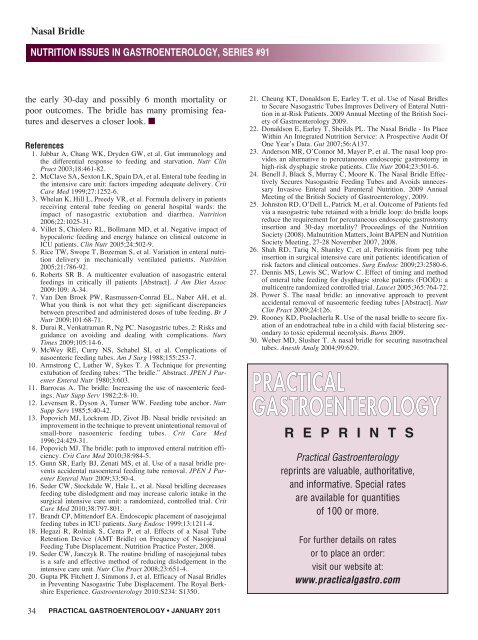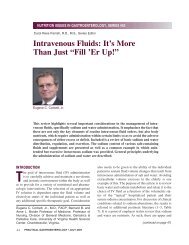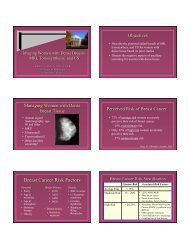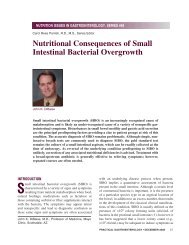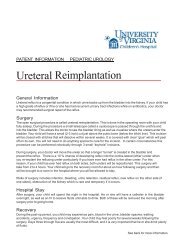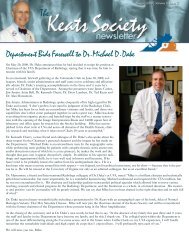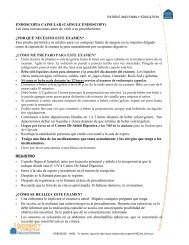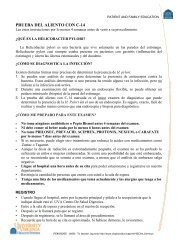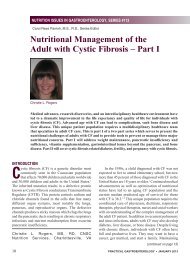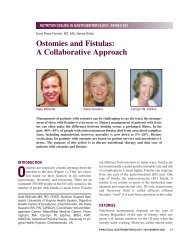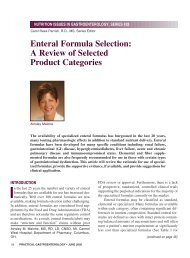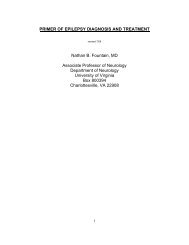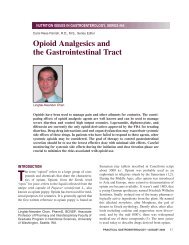Nasal Bridle: Married to Your Tube - Medicine - University of Virginia
Nasal Bridle: Married to Your Tube - Medicine - University of Virginia
Nasal Bridle: Married to Your Tube - Medicine - University of Virginia
Create successful ePaper yourself
Turn your PDF publications into a flip-book with our unique Google optimized e-Paper software.
<strong>Nasal</strong> <strong>Bridle</strong><br />
NUTRITION ISSUES IN GASTROENTEROLOGY, SERIES #91<br />
the early 30-day and possibly 6 month mortality or<br />
poor outcomes. The bridle has many promising features<br />
and deserves a closer look. n<br />
References<br />
1. Jabbar A, Chang WK, Dryden GW, et al. Gut immunology and<br />
the differential response <strong>to</strong> feeding and starvation. Nutr Clin<br />
Pract 2003;18:461-82.<br />
2. McClave SA, Sex<strong>to</strong>n LK, Spain DA, et al. Enteral tube feeding in<br />
the intensive care unit: fac<strong>to</strong>rs impeding adequate delivery. Crit<br />
Care Med 1999;27:1252-6.<br />
3. Whelan K, Hill L, Preedy VR, et al. Formula delivery in patients<br />
receiving enteral tube feeding on general hospital wards: the<br />
impact <strong>of</strong> nasogastric extubation and diarrhea. Nutrition<br />
2006;22:1025-31.<br />
4. Villet S, Chiolero RL, Bollmann MD, et al. Negative impact <strong>of</strong><br />
hypocaloric feeding and energy balance on clinical outcome in<br />
ICU patients. Clin Nutr 2005;24:502-9.<br />
5. Rice TW, Swope T, Bozeman S, et al. Variation in enteral nutrition<br />
delivery in mechanically ventilated patients. Nutrition<br />
2005;21:786-92.<br />
6. Roberts SR B. A multicenter evaluation <strong>of</strong> nasogastric enteral<br />
feedings in critically ill patients [Abstract]. J Am Diet Assoc<br />
2009:109: A-34.<br />
7. Van Den Broek PW, Rasmussen-Conrad EL, Naber AH, et al.<br />
What you think is not what they get: significant discrepancies<br />
between prescribed and administered doses <strong>of</strong> tube feeding. Br J<br />
Nutr 2009;101:68-71.<br />
8. Durai R, Venkatraman R, Ng PC. Nasogastric tubes. 2: Risks and<br />
guidance on avoiding and dealing with complications. Nurs<br />
Times 2009;105:14-6.<br />
9. McWey RE, Curry NS, Schabel SI, et al. Complications <strong>of</strong><br />
nasoenteric feeding tubes. Am J Surg 1988;155:253-7.<br />
10. Armstrong C, Luther W, Sykes T. A Technique for preventing<br />
extubation <strong>of</strong> feeding tubes: “The bridle.” Abstract. JPEN J Parenter<br />
Enteral Nutr 1980;3:603.<br />
11. Barrocas A. The bridle: Increasing the use <strong>of</strong> nasoenteric feedings.<br />
Nutr Supp Serv 1982;2:8-10.<br />
12. Levensen R, Dyson A, Turner WW. Feeding tube anchor. Nutr<br />
Supp Serv 1985;5:40-42.<br />
13. Popovich MJ, Lockrem JD, Zivot JB. <strong>Nasal</strong> bridle revisited: an<br />
improvement in the technique <strong>to</strong> prevent unintentional removal <strong>of</strong><br />
small-bore nasoenteric feeding tubes. Crit Care Med<br />
1996;24:429-31.<br />
14. Popovich MJ. The bridle: path <strong>to</strong> improved enteral nutrition efficiency.<br />
Crit Care Med 2010;38:984-5.<br />
15. Gunn SR, Early BJ, Zenati MS, et al. Use <strong>of</strong> a nasal bridle prevents<br />
accidental nasoenteral feeding tube removal. JPEN J Parenter<br />
Enteral Nutr 2009;33:50-4.<br />
16. Seder CW, S<strong>to</strong>ckdale W, Hale L, et al. <strong>Nasal</strong> bridling decreases<br />
feeding tube dislodgment and may increase caloric intake in the<br />
surgical intensive care unit: a randomized, controlled trial. Crit<br />
Care Med 2010;38:797-801.<br />
17. Brandt CP, Mittendorf EA. Endoscopic placement <strong>of</strong> nasojejunal<br />
feeding tubes in ICU patients. Surg Endosc 1999;13:1211-4.<br />
18. Hegazi R, Rolniak S, Centa P, et al. Effects <strong>of</strong> a <strong>Nasal</strong> <strong>Tube</strong><br />
Retention Device (AMT <strong>Bridle</strong>) on Frequency <strong>of</strong> Nasojejunal<br />
Feeding <strong>Tube</strong> Displacement. Nutrition Practice Poster, 2008.<br />
19. Seder CW, Janczyk R. The routine bridling <strong>of</strong> nasojejunal tubes<br />
is a safe and effective method <strong>of</strong> reducing dislodgement in the<br />
intensive care unit. Nutr Clin Pract 2008;23:651-4.<br />
20. Gupta PK Fitchett J, Simmons J, et al. Efficacy <strong>of</strong> <strong>Nasal</strong> <strong>Bridle</strong>s<br />
in Preventing Nasogastric <strong>Tube</strong> Displacement. The Royal Berkshire<br />
Experience. Gastroenterology 2010:S234: S1350.<br />
34<br />
PRACTICAL GASTROENTEROLOGY JANUARY 2011<br />
21. Cheung KT, Donaldson E, Earley T, et al. Use <strong>of</strong> <strong>Nasal</strong> <strong>Bridle</strong>s<br />
<strong>to</strong> Secure Nasogastric <strong>Tube</strong>s Improves Delivery <strong>of</strong> Enteral Nutrition<br />
in at-Risk Patients. 2009 Annual Meeting <strong>of</strong> the British Society<br />
<strong>of</strong> Gastroenterology 2009.<br />
22. Donaldson E, Earley T, Sheilds PL. The <strong>Nasal</strong> <strong>Bridle</strong> - Its Place<br />
Within An Integrated Nutrition Service: A Prospective Audit Of<br />
One Year’s Data. Gut 2007;56:A137.<br />
23. Anderson MR, O’Connor M, Mayer P, et al. The nasal loop provides<br />
an alternative <strong>to</strong> percutaneous endoscopic gastros<strong>to</strong>my in<br />
high-risk dysphagic stroke patients. Clin Nutr 2004;23:501-6.<br />
24. Benell J, Black S, Murray C, Moore K. The <strong>Nasal</strong> <strong>Bridle</strong> Effectively<br />
Secures Nasogastric Feeding <strong>Tube</strong>s and Avoids unnecessary<br />
Invasive Enteral and Parenteral Nutrition. 2009 Annual<br />
Meeting <strong>of</strong> the British Society <strong>of</strong> Gastroenterology, 2009.<br />
25. Johns<strong>to</strong>n RD, O’Dell L, Patrick M, et al. Outcome <strong>of</strong> Patients fed<br />
via a nasogastric tube retained with a bridle loop: do bridle loops<br />
reduce the requirement for percutaneous endoscopic gastros<strong>to</strong>my<br />
insertion and 30-day mortality? Proceedings <strong>of</strong> the Nutrition<br />
Society (2008). Malnutrition Matters, Joint BAPEN and Nutrition<br />
Society Meeting, 27-28 November 2007, 2008.<br />
26. Shah RD, Tariq N, Shanley C, et al. Peri<strong>to</strong>nitis from peg tube<br />
insertion in surgical intensive care unit patients: identification <strong>of</strong><br />
risk fac<strong>to</strong>rs and clinical outcomes. Surg Endosc 2009;23:2580-6.<br />
27. Dennis MS, Lewis SC, Warlow C. Effect <strong>of</strong> timing and method<br />
<strong>of</strong> enteral tube feeding for dysphagic stroke patients (FOOD): a<br />
multicentre randomized controlled trial. Lancet 2005;365:764-72.<br />
28. Power S. The nasal bridle: an innovative approach <strong>to</strong> prevent<br />
accidental removal <strong>of</strong> nasoenteric feeding tubes [Abstract]. Nutr<br />
Clin Pract 2009;24:126.<br />
29. Rooney KD, Poolacherla R. Use <strong>of</strong> the nasal bridle <strong>to</strong> secure fixation<br />
<strong>of</strong> an endotracheal tube in a child with facial blistering secondary<br />
<strong>to</strong> <strong>to</strong>xic epidermal necrolysis. Burns 2009.<br />
30. Weber MD, Slusher T. A nasal bridle for securing nasotracheal<br />
tubes. Anesth Analg 2004;99:629.<br />
PRACTICAL<br />
GASTROENTEROLOGY<br />
R E P R I N T S<br />
Practical Gastroenterology<br />
reprints are valuable, authoritative,<br />
and informative. Special rates<br />
are available for quantities<br />
<strong>of</strong> 100 or more.<br />
For further details on rates<br />
or <strong>to</strong> place an order:<br />
visit our website at:<br />
www.practicalgastro.com


